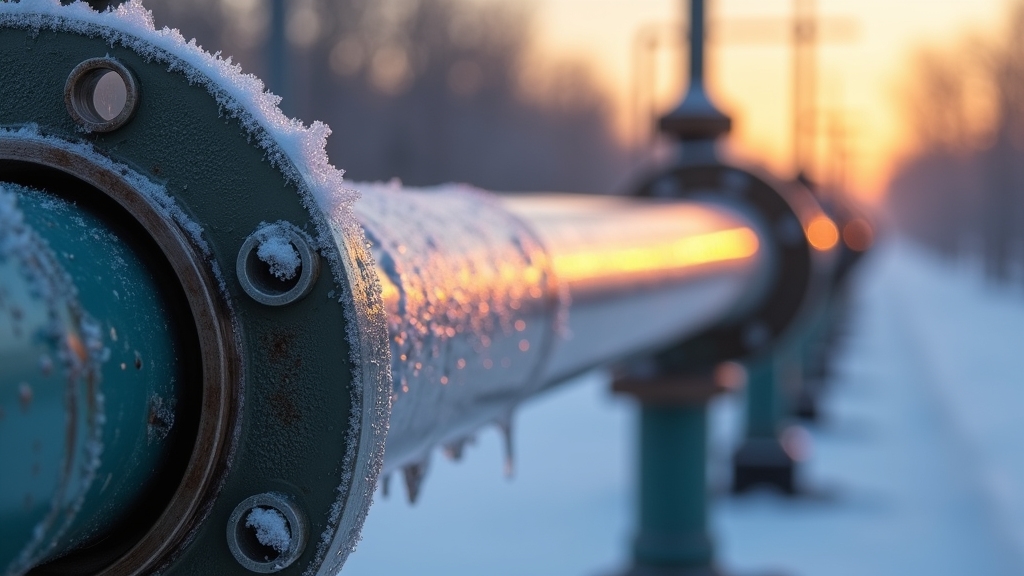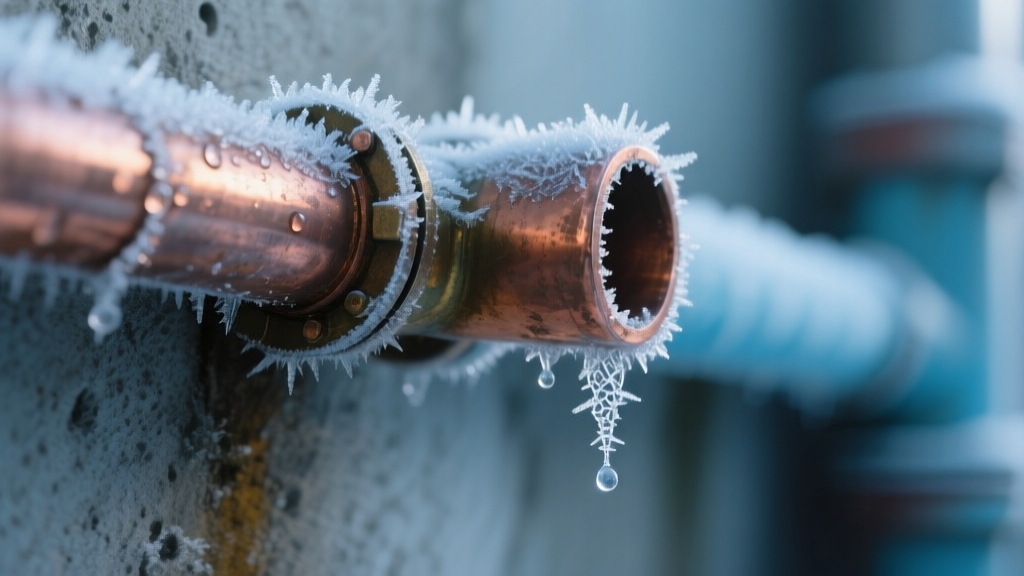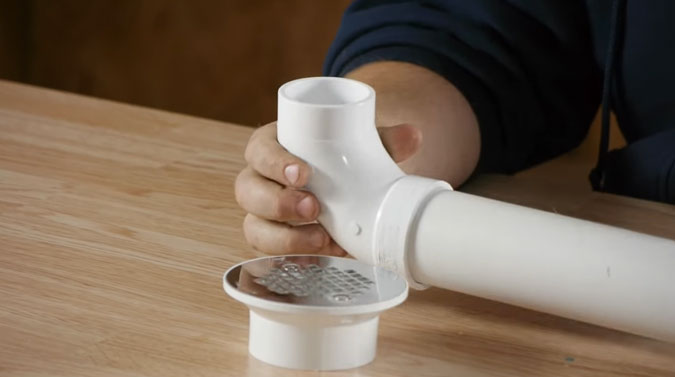You won’t see natural gas freezing in pipes under normal conditions since its freezing point is extremely low, around -183°C (-297°F).
However, moisture inside pipes can freeze at typical freezing temperatures, causing blockages or damage. This often happens in unheated or poorly insulated spaces where water vapor condenses and freezes.
You’ll want to watch for frost, bulging pipes, or cold spots and use insulation and sealing to prevent issues. Understanding the causes and prevention can help you protect your gas lines effectively.
Key Takeaways
- Natural gas, primarily methane, freezes at extremely low temperatures around -183°C, making freezing in pipes under normal conditions highly unlikely.
- Moisture inside gas pipes can freeze at 0°C, causing blockages and pipe damage even though the gas itself does not freeze.
- Frozen moisture or gas hydrates form in pipes due to cold, moisture, and pressure, leading to flow restrictions and safety hazards.
- Proper insulation, sealing, and maintaining indoor temperatures above 55°F prevent moisture freezing and protect gas pipes from cold exposure.
- Regular monitoring and maintenance detect early signs of freezing, reducing risks of leaks, ruptures, and interruptions in gas supply.
Understanding the Freezing Point of Natural Gas

Although natural gas is often associated with freezing issues in pipelines, the gas itself rarely freezes under typical conditions. This is because methane, the primary component, has an extremely low freezing point of about -297°F (-183°C).
Natural gas rarely freezes because methane’s freezing point is an incredibly low -297°F (-183°C).
This temperature is far below any natural Earth environment, making solidification of methane practically impossible without industrial refrigeration. However, water present in the gas mixture can form gas hydrates at low temperatures and high pressure, causing blockages in pipes.
You should also note that natural gas typically isn’t pure; it contains other hydrocarbons and contaminants. However, these rarely influence freezing behavior remarkably.
Methane’s freezing point is so low that it’s more common in outer space than on Earth.
Common Causes of Gas Pipe Freezing
Freezing issues in gas pipes usually stem from factors other than the natural gas itself, since methane’s freezing point is far below typical environmental temperatures.
The main culprits are moisture inside the lines, poor insulation, and exposure to extreme cold. Proper maintenance procedures can help identify and mitigate these risks early.
Moisture entering gas pipes through leaks or pressure changes can freeze at 32°F, causing blockages.
Pipes in unheated spaces like basements or exterior walls are vulnerable when insulation is inadequate or damaged. Insulating pipes with sleeves or spray foam creates a barrier against cold temperatures.
Sudden temperature drops and frost heave can physically stress pipes, worsening freeze risks.
Additionally, poor sealing and ventilation allow cold air or moisture ingress, while low indoor thermostat settings reduce ambient warmth around pipes.
Identifying Signs of Frozen Gas Pipes

If you spot some visible ice or frost on your gas pipes, that’s a pretty strong indication that they could be freezing up inside. It’s a good idea to keep an eye out for that! Frozen gas lines pose safety risks, including leaks and appliance failure.
And if you suddenly find that your appliances aren’t getting any gas, it’s often due to a blockage caused by frozen gas. Catching these signs early can really help you avoid any potential damage or interruptions to your service.
So, stay vigilant and take action if you see something off! Regular maintenance and inspection of pipes can help prevent issues like freezing and blockages caused by debris.
Visible Ice Formation
A clear sign of frozen gas pipes is visible ice or frost forming on their surfaces. You’ll often see this on exposed sections in basements, attics, garages, or exterior walls where temperatures drop near or below 32°F (0°C). Using a thermostat or timer can help regulate temperatures in vulnerable areas to prevent freezing.
Frost indicates internal water has frozen, which risks ice blockages inside the pipe. Look for bulging or swelling on metal or plastic pipes caused by water expansion during freezing; this signals stress and potential rupture.
When you spot frost or bulging, act immediately to avoid damage. Avoid high heat or open flames when thawing, as rapid warming can worsen pipe integrity. Contacting a professional plumber is the safest way to ensure proper and safe thawing without causing further harm.
Visible ice formation serves as a practical, early warning that your gas pipes are at risk and need prompt attention.
Sudden Gas Loss
When your gas appliances suddenly stop working, you might be dealing with frozen gas pipes blocking fuel flow. This blockage disrupts the fuel supply, causing a complete lack of gas at your stove, furnace, or water heater. One common cause of pressure problems in related systems is a clogged filter that restricts flow.
To identify frozen gas pipes, watch for these signs:
- No gas flow or flame in all appliances simultaneously without other causes.
- Unusual noises like hissing, clinking, or sputtering when gas tries to pass ice obstructions.
- Cold pipe surfaces or areas around gas lines feeling unusually cold compared to the environment. Such cold temperatures often result from extremely cold temperatures that cause water in lines to freeze.
- Noticeable drops or fluctuations in gas pressure at outlets or gauges indicate restricted flow.
Recognizing these signs early helps prevent hazards and ensures prompt action to restore safe gas delivery.
Potential Hazards Associated With Frozen Gas Lines
Although frozen gas lines might seem like a minor inconvenience, they pose serious hazards that you need to recognize and address promptly.
Ice inside pipes restricts gas flow, causing incomplete combustion that produces deadly carbon monoxide, a colorless, odorless toxin risking poisoning in enclosed spaces. Submersible pumps, unlike gas lines, have a sealed construction that prevents air leaks, highlighting the vulnerability of gas pipes to freezing and leaks.
Frozen pipes can crack or leak as ice expands, increasing the chance of gas leaks that may ignite, leading to fires or explosions.
Pressure buildup from blockages might cause pipe ruptures. Additionally, freezing disrupts gas supply, impairing heating and critical appliances, which is dangerous in cold conditions. Gas lines are designed to prevent freezing, but issues typically occur in unheated or exposed areas, where moisture and condensation can accumulate.
Structural damage from frost heave further compromises pipeline integrity, causing leaks or failures.
Gas leaks also release methane and pollutants, harming the environment and public health.
You must treat frozen gas lines with urgency to prevent these severe risks.
Effective Prevention Measures for Gas Pipe Freezing

To keep gas pipes from freezing, it’s really important to use the right insulation techniques. This helps maintain the temperature of the pipes, making freezing less likely. Using materials with good heat retention properties can further enhance the effectiveness of insulation.
Also, don’t forget about regular leak detection! Even tiny leaks can let moisture in, which can lead to ice blockages.
And hey, scheduling professional maintenance is a smart move, too. It ensures your system stays reliable and helps catch any potential freeze issues before they become a problem. Using heat tracing systems can provide even heat distribution to maintain safe temperatures in gas pipes during cold weather.
Insulation Techniques
Effective insulation techniques play a crucial role in preventing gas pipe freezing by maintaining consistent thermal protection against cold temperatures.
To keep your pipes safe, you’ll want to focus on the right materials and installation methods. Here’s what you should consider:
- Use foam or rubber foam insulation sleeves for flexible, moisture-resistant coverage, especially on irregular or exterior pipes.
- Apply fiberglass wrap combined with vapor barriers for higher temperature tolerance and condensation control.
- Seal joints and fittings with self-sealing foam tapes or polyethylene wraps to maintain insulation integrity.
- Add insulated freeze jackets or heat cables alongside insulation for active temperature control in extreme cold. Insulation reduces the risk of freezing and potential pipe bursts.
- Additionally, sealing air leaks around pipes can enhance the effectiveness of insulation by minimizing cold air infiltration. Adjusting water pressure valve settings can also help regulate pipe stress that might contribute to freezing damage.
Leak Detection
How can you detect and prevent gas pipe freezing before it causes damage? Start by installing freeze detection systems and freezing point sensors to monitor temperature shifts that signal potential ice formation. Using thermal monitoring can enhance the accuracy of freeze detection by providing continuous temperature data.
Regularly inspect pipes for moisture or ice signs, and continuously track gas flow and pressure to spot anomalies indicating blockages or freeze risks. Use thermal monitoring and remote systems for real-time data. Maintaining proper operational conditions is essential to prevent ice formation and related issues.
Prevent freezing by managing flow rates and pipeline temperatures, employing glycol dehydration, methanol injection, and chemical inhibitors to reduce water and hydrate formation.
Professional Maintenance
Professional maintenance is key to effective prevention. Regular checks help spot insulation damage, leaks, or cold air infiltration early. Additionally, ensuring proper drainage around piping can prevent water accumulation that contributes to freezing.
Here’s what you should focus on:
- Insulate pipes using foam or heat tape, ensuring proper installation to avoid hazards.
- Maintain indoor temperatures above 55°F (13°C) to keep pipes warm. Water inside pipes can freeze at around 14°F (-10°C) if flowing, so maintaining adequate warmth is essential.
- Seal gaps in walls and windows to block cold air from reaching pipes. This also helps promote proper drainage by preventing moisture buildup near the pipes.
- Use localized heat sources or heating cables in vulnerable areas like basements or attics.
Staying proactive with these measures reduces freezing risks and ensures reliable gas flow during cold weather. Schedule routine inspections and address issues promptly for maximum pipe protection.
Environmental and Geographic Factors Affecting Gas Pipe Freezing
Although gas pipelines operate underground, environmental and geographic factors considerably impact their vulnerability to freezing.
Soil conditions like high moisture and silty textures increase frost heave risk, displacing pipes near the surface. This displacement can cause pipe leaks that compromise system integrity.
Cold climates with prolonged subzero temperatures intensify freezing risks, especially where humidity accelerates frost formation. It is important to note that frost heave caused 82% of cold weather damage incidents from 1984 to 2014, highlighting its significant impact on pipeline integrity.
Geographic areas with cyclic freeze-thaw stress pipelines repeatedly, while soil expansion and contraction reduce burial depth, causing mechanical strain.
| Factor | Impact | Key Detail |
|---|---|---|
| Soil Moisture | Increases frost heave | Up to 28.7% in river regions |
| Soil Type | Affects frost susceptibility | Silty/loamy worst; gravel better |
| Temperature | Controls ice formation risk | As low as −9 °C in cold climates |
| Freeze-Thaw Cycles | Causes soil and pipe movement | Repeated stress and bending |
| Humidity | Accelerates surface frost | Higher moisture levels |
Understanding these factors helps you assess freezing risks effectively.
Best Practices for Maintaining Gas Line Integrity in Cold Weather
Maintaining gas line integrity during cold weather requires regular inspections and proactive measures to prevent freezing and damage.
You should schedule a professional seasonal inspection to identify risks like corrosion, ice buildup on regulators, and valve stiffness. Keeping gas lines dry and insulated reduces the chance of ice blockages. Moisture-heavy winter conditions can accelerate rust on older or unprotected pipes, so preventing corrosion is also crucial.
Clearing snow from vents and meters ensures proper ventilation. Monitor gas pressure and appliance function to detect issues early.
Follow these best practices:
- Inspect outdoor pipes, valves, and regulators before winter sets in.
- Insulate exposed gas lines and use heat trace cables where necessary.
- Maintain indoor temperatures above 55°F (13°C) to prevent freezing.
- Know your shut-off valve location and test its operation regularly.
These steps help you maintain safe and reliable gas flow during cold seasons.
Frequently Asked Questions
Can Freezing Gas Pipes Affect Gas Meter Accuracy?
Yes, freezing gas pipes can considerably affect your gas meter accuracy.
Ice or hydrate formation inside meter components blocks pressure taps and sensing ports, disrupting flow measurement. This causes your meter to underestimate or overestimate gas flow, leading to inaccurate readings.
Frozen meters also cause erratic control system behavior, increasing errors and operational risks. You’ll face revenue losses and potential system instability unless you address freezing promptly and maintain proper drying and monitoring measures.
How Quickly Can Frozen Pipes Thaw Naturally Without Damage?
Think of frozen pipes as a slow-moving glacier. You can’t rush their melt without risk.
Naturally, you’ll see thawing take anywhere from a few hours to several days, depending on location, insulation, and temperature stability.
To avoid damage, you should keep faucets open to relieve pressure and gently warm pipes when possible.
Rapid temperature swings or closed valves increase burst risk. Patience and controlled warming are key to safe, natural thawing.
Are Gas Pipe Freeze Risks Different for Commercial vs. Residential Properties?
Yes, gas pipe freeze risks differ between commercial and residential properties.
You’ll find commercial pipes often in unheated, exposed areas, increasing freeze risk, especially with complex layouts and multiple wall penetrations.
Residential pipes are usually simpler and better insulated inside heated walls, reducing risk.
Still, both can freeze if exposed to cold, especially exterior pipes.
Proper insulation and maintenance matter more in commercial setups to prevent costly freeze damage.
Does Pipe Material Influence Susceptibility to Freezing?
You might think all pipes freeze the same, but pipe material heavily influences freezing susceptibility.
Metal pipes like copper and steel conduct heat efficiently but can handle ice expansion better than brittle plastics.
PVC, for example, is prone to cracking under freezing stress, while flexible PEX resists rupture and offers better thermal resistance.
Can Frozen Gas Pipes Trigger Home Insurance Claims?
Frozen gas pipes rarely trigger home insurance claims because gas lines typically don’t contain water and don’t freeze like water pipes.
However, if moisture inside the gas line freezes and causes damage, you might have a claim.
Most claims focus on water damage from frozen, burst water pipes.
To avoid surprises, check your policy details and guarantee you maintain your gas and water systems properly to prevent costly issues.
Insulation and Inspection: Your Best Defense Against Freezing
You might be surprised to learn that natural gas itself doesn’t freeze under normal conditions because its freezing point is around -260°F (-162°C). However, the moisture and impurities inside pipes can freeze, causing blockages and hazards.
To avoid issues, regularly inspect and insulate your gas lines, especially if you live in regions where temperatures drop below freezing. Staying proactive can prevent costly damage and ensure your gas system runs safely throughout the cold season.


